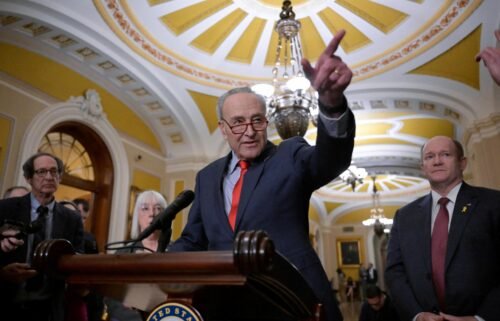For Black runners, every stride comes with a fear they can’t outrun

Every time Roy Oduor laces up his bright red sneakers for a run in his Kansas neighborhood, he goes through a checklist of precautions.
He wears a brightly colored wool hat in the winter, fearing a dark one could get him mistaken for a ski mask-donning attacker. He throws on a reflective vest to make it clear he’s a runner and not a loiterer. When he sees police officers, he waves emphatically so they can remember him as a nonthreatening jogger if he’s ever wrongfully accused of anything.
For Black runners like Oduor, every stride comes with a fear that can’t be outrun. After Ahmaud Arbery’s shooting death a year ago as two White men pursued him while he was jogging, Black runners told CNN they’ve become even more vigilant.
“I take extra measures to make myself look like a runner and make sure nothing arouses any suspicion,” said Oduor, 42, who lives in the majority-White city of Lenexa and started running six years ago after he was diagnosed with prediabetes.
“I avoid residential areas and use main roads. I panic if a car is following too closely during my runs. I make sure my phone is fully charged and I can hit record anytime.”
To them, ‘running while Black’ is nothing new
Arbery, 25, was jogging near his neighborhood in coastal Georgia when he was shot by a father and son duo who now face murder and other charges, prosecutors have said. They have pleaded not guilty.
In a separate incident, a woman in New York City was charged with attempted assault as a hate crime and aggravated harassment after she was captured on video in August hurling a racial slur at a Black runner. She pleaded not guilty and is next due in court in March, her attorney told CNN.
The cases have become yet more examples of the many perils Black people face while engaged in ordinary activities.
It’s unclear what percentage of runners nationwide identify as minorities, but their numbers have grown rapidly in recent years, said Tony Reed, cofounder of the National Black Marathoners Association. Most running events in the United States collect data on runners’ gender and age — but not ethnicity — making it difficult to get credible stats, he added.
Reed, 65, describes himself as a “semi-retired” runner who logs a few miles a day in his Dallas neighborhood. The phenomenon dubbed “running while Black” is nothing new, he said. Arbery’s death just made people pay more attention.
“People have spit on me while I’m running, called me the N-word, milk cartons have been thrown at me,” he said. “Some people have stopped or asked if I’m lost when I’m running in White neighborhoods. One thing I did was study judo and karate simply because I cannot carry a gun while I’m running. I needed to protect myself.”
When he worked as a running coach, Reed encouraged his students to take self-defense classes, he said.
Black women face an extra burden
Black runners are constantly aware that doing something they love comes with inherent risks, said Alison Désir, cochair of the Running Industry Diversity Coalition.
“For Black and brown runners, many of us have always known that you’re subject to potential violence. This is not new to us,” she said. “What’s new is that finally some White people have witnessed an awakening, a tipping point.”
An avid runner, Désir never runs in the dark and makes sure her hands are not in her pockets when she runs past police officers, she said. She avoids running in only shorts and a sports bra — an added burden for female runners fearful of attacks for dressing in a way some may consider provocative.
“As a Black woman, I cannot divorce the two — which I experience for being Black or which I experience for being a woman. My experience is intersectional as someone with both identities,” she said.
Women’s Running magazine named Désir one of its 25 people reshaping the running industry for the better. After Arbery’s killing, the mental health advocate and founder of several running organizations spearheaded broader conversations on racism in the running world.
Under the umbrella of the Running Industry Diversity Coalition, companies and running organizations have teamed up to increase diversity and ensure Black, indigenous and people of color are represented in the sport, she said.
The coalition’s fight for equality goes beyond racial discrimination to include religion, gender identity, sexuality and immigration status. Part of its effort includes hosting educational sessions for those in the running industry on decision-making, authentic marketing and hiring practices.
“The idea that you can go outside to do something that you enjoy and love, and get gunned down … is really devastating,” she said. “But I’m really hopeful. I hope that running truly can become an activity that anyone can ultimately participate in, that a lot of people are able to run without fear.”
Their fears are rooted in systemic racism
Other organizations aim to create more awareness and advocate for changes to keep Black runners safe.
Edward Walton cofounded Black Men Run in Atlanta eight years ago to encourage African Americans to stay healthy. It has since grown into a national organization with tens of thousands of members and chapters in 32 states.
It also has morphed into a brotherhood of men running together to ensure safety in numbers. After Arbery’s death, members of the group started taking more safety measures, Walton said.
“Unfortunately, it’s like doing a math test or a calculus test where you have to factor in so many things,” Walton said. “Like the time of day. Where am I running? What clothes am I running in? Something as mundane as how fast I’m I running? Does it look like I’m running away from something?”
Still, the issue of running while Black goes beyond surface factors and is rooted in systemic racism, Walton said. “If you can cure that, you can cure the majority of things that are ailing this country,” he said.
They are slowly changing the face of running
Running has not always appealed to young Black men because, unlike other sports such as basketball and football, there’s no money in it except for elite athletes, Walton said. Some Black people also have shunned running because they falsely believe it causes knee damage, Reed said.
But perceptions are changing as more minority runners hit the pavement, reap physical benefits and win notable races, they said.
The shifting culture also mirrors the time when tennis and golf were considered “White sports,” Walton said. When Serena and Venus Williams and Tiger Woods started playing, they helped draw more diverse fans and players, and he said he expects the same will happen with running.
As groups like Black Men Run and the National Black Marathoners Association work to encourage minorities to run regardless of their level of athleticism, they and organizations including the Running Industry Diversity Coalition and the Atlanta Track Club are combating racism in the running community.
The Atlanta club, perhaps the largest such organization near where Arbery was killed, recently expanded its diversity committee and launched conversations about the problem, a spokesperson said.
“The goal is to understand each other’s perspectives and also share those perspectives with our broader community,” Jay Holder said. “We believe that running and walking should be universally accessible and personal safety due to the color of someone’s skin should not be a barrier.”
Despite the fear and exhausting precautions, Oduor said he’ll take his chances with running.
His doctor gave him two options: run or lose a limb to diabetes.


